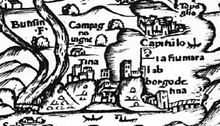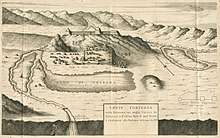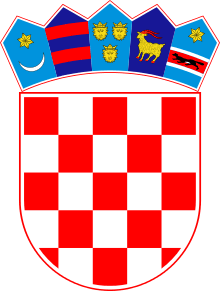Siege of Knin
The Siege of Knin (Croatian: Opsada Knina) was a siege of the city of Knin, the capital of the Kingdom of Croatia, by the Ottoman Empire in 1522. After two failed attempts in 1513 and 1514, Ottoman forces led by Ghazi Husrev-beg, sanjak-bey (governor) of the Sanjak of Bosnia, launched a major offensive on southern parts of Croatia in the spring of 1522. In May, his forces, reinforced with troops from the Sanjak of Herzegovina and Constantinople, besieged the Knin Fortress. Due to frequent confrontations and raids of its surroundings, the fortress was already damaged and a large part of the local population fled to safer parts of Croatia. Croatian nobleman Mihajlo Vojković, the commander of Knin's defence, had only a small garrison at his disposal. He surrendered the fortress on 28 May, in exchange for a free departure of his soldiers. The Ottomans entered the city on the following day. Croatian Ban Ivan Karlović, who was preparing a relief effort to help the besieged Knin, had Vojković imprisoned for surrendering the city. Soon after its capture, the Ottomans made Knin a part of the Croat vilayet within the Sanjak of Bosnia. In 1580, Knin became the seat of the Sanjak of Krka and Lika.
| Siege of Knin | |||||||||
|---|---|---|---|---|---|---|---|---|---|
| Part of the Ottoman wars in Europe Hundred Years' Croatian-Ottoman War | |||||||||
 Knin on a 1522 map | |||||||||
| |||||||||
| Belligerents | |||||||||
|
|
| ||||||||
| Commanders and leaders | |||||||||
|
Ghazi Husrev-beg Mahmud-beg |
Mihajlo Vojković | ||||||||
| Strength | |||||||||
| 25,000 soldiers | small garrison | ||||||||
Background
In the early 16th century, the border of the Kingdom of Croatia towards the Ottoman Empire was guarded by six major forts. The fortified city of Knin in northern Dalmatia, positioned on the upper Krka River, kept watch on the nearby Sanjak of Bosnia. This area was under the authority of the ban of Croatia.[1]
The Croatian defeat at Krbava field at the hands of the Ottomans in 1493, that was preceded by the first Ottoman siege of Knin, marked the beginning of the largest emigration from the city and its surroundings to safer parts of Croatia. Knin, the capital city of Croatia and the seat of the ban, was slowly losing its status as the political and administrative center of the kingdom. Its Supreme court ceased to function, ban's deputy no longer had civil duties, and all efforts were focused on the buildup of Knin's fortifications.[2] The city was also the seat of a Roman Catholic diocese. Due to the Ottoman threat, the bishop of Knin moved to Cazin.[3]
In September 1502, 2,600 Ottoman cavalrymen looted the area around Knin.[4] On 20 August 1503, King Vladislaus II concluded a 7-year peace treaty with Sultan Bayezid II.[5] The armistice was used to strengthen Knin's defences in the following year. In 1505, Dalmatia experienced a period of severe famine that affected Knin as well. In 1510, an outbreak of the plague almost halved Knin's population.[2]
A new 5 year peace treaty was signed after the previous one expired, in 1511. Sanjak-beys from Herzegovina and Bosnia did not honor the new ceasefire and were often raiding the countryside of the Croatian border towns.[5] In a report on 5 May 1511 to the parliament in Budim, the king's courtier stated that Knin was under constant Ottoman assaults and that the whole of Croatia will be lost if the city fell.[6] Hungary had its own financial troubles and could not allocate enough resources to help Croatia's defences.[7] The Croatian nobles turned to the papal court for aid in the war with the Ottoman Empire. Petar Berislavić, the ban of Croatia from 1513 to 1520, received around 50,000 ducats in subsidies from the Pope during his tenure.[8]
Some local Croatian nobles made accommodations with the Ottomans to protect their possessions from raids, in the form of annual tributes to the sanjak-bey of Bosnia. In the councils of 1507 and 1511, the Croatian nobility concluded that if the king did not provide more help, they would be forced to pay tribute to the sultan themselves. Venice reported that their coastal cities in the eastern Adriatic were no longer secure due to local agreements of Croatian forts in the hinterland with the Ottomans.[9] These agreements were contained to a local level and did not lead to a cesation of hostilities.[10]
With the accession of Selim I as sultan in 1512, all peace treaties were annulled. The entire Banate of Srebrenik was captured in the autumn of the same year.[5] Thus, the defence system established by King Matthias Corvinus in 1464 was breached.[11] Ban Petar Berislavić, whose tenure was marked with continuous battles with the Ottoman Empire, focused on defending the area around the Una River. In August 1513, he won a great victory against the Ottomans at the battle of Dubica. In May 1520, he was killed in an Ottoman ambush at the battle of Plješevica.[12] Most of the Croatian nobles supported Ivan Karlović, the head of the Kurjaković family, to replace Berislavić. King Louis II, who succeeded Vladislaus II, had second thoughts on that request and the position of ban remained vacant for another year.[13]
Failed siege attempts
In 1510, the captain of Knin negotiated a joint defence with the captain of the Venetian-held coastal city of Šibenik.[6] He reported that Knin was locked down due to the activities of Ottoman irregular soldiers and the lack of reinforcements.[7] In the same year, around 1,000 Ottoman akinji (irregular light cavalry) raided the countryside of Knin. According to some sources, the vice ban of Croatia was captured on that occasion. Three years later, in January 1513, there was another unsuccessful siege of Knin.[14] The Croatian ban ordered vice ban Baltazar Baćan (Hungarian: Boldizsár Batthyány) to gather forces and lift the siege with the help from the Archdiocese of Zagreb. The ban called for a general uprising in the country on that occasion.[15] In February of the following year, a 10,000-strong Ottoman army besieged Knin, but was unable to take the fortress and lost 500 troops. The settlement beneath the fortress was burned on this occasion.[16][14] The Bosnian sanjak-bey constructed two new forts on the border near Skradin in 1517, to aid him in future offensives.[8]
The local population was decimated by war, hunger, plague, and migration to safer places, and the city's economy was hindered by the seizure of crops and livestock.[17] The captains of Knin and Skradin traveled to Buda and offered their resignations in October 1521, explaining that they did not have enough resources to withstand Ottoman assaults. King Louis II and his council persuaded them to remain in their positions,[18] and promised reinforcements of 1,000 infantry and 1,000 cavalrymen, though it is not known how many of these forces arrived to the two captains.[17]
Prelude and final siege
In November 1521, Ivan Karlović was named the new ban of Croatia. Shortly after assuming the position, he was faced with an Ottoman takeover of the town of Bužim, in possession of Petar Keglević, the ban of Jajce, after a large number of imprisoned Ottoman soldiers managed to free themselves. Karlović led an army to recapture it, and negotiated the surrender of the town in exchange for the release of prisoners to Ottoman-held territory.[19] In March 1522, there were more conflicts on the border. Karlović expected an Ottoman attack on Krupa and Bihać or on the region of Lika.[20] From a captured Ottoman soldier, the ban's forces learned that the Ottomans were preparing a larger offensive,[21] ordered by the new sultan, Suleiman, following his capture of Belgrade in August 1521. The sultan saw the offensive as a punishment for the failure of negotiations with the Croatian nobles, who probably used the negotiations to gain time.[22]
The offensive was entrusted to Ghazi Husrev-beg, sanjak-bey of Bosnia, and Mahmud-beg, the sanjak-bey of Herzegovina. Mahmud-beg was the son of Ottoman general and statesman Hersekzade Ahmed Pasha.[20] Ghazi Husrev-beg was appointed sanjak-bey of Bosnia in September 1521, after he distinguished himself during the siege of Belgrade and earned the title Ghazi. Before coming to Bosnia, he was the sanjak-bey of Smederevo.[23] The offensive began in early April, with coordinated attacks across the Croatian-Ottoman border, and a raid into the neighbouring Archduchy of Austria. Additional Ottoman troops from Constantinople were sent in aid to the two sanjak-beys. Karlović's forces, numbering 2,000 cavalrymen and reinforced with troops from Austria, intercepted and defeated one Ottoman group returning to Bosnia in mid April.[24]
Ghazi Husrev-beg first led his forces on a raid into Carniola. Other Ottoman units made probing attacks on Knin and Skradin,[23] which were marked as the main targets in the first phase of the offensive.[25] Ghazi Husrev-beg's forces raided the area around the towns of Grobnik, Ledenik, Brinje, and Modruš, in central Croatia.[20] They reached Knin in May, where Ghazi Husrev-beg was joined by Mahmud-beg. The two sanjak-beys had an army of 25,000 soldiers and a large amount of artillery,[26] which was positioned opposite of the fortress.[25] The fortress of Knin was defended by Mihajlo Vojković from Klokoč, a Croatian nobleman who had only a small garrison at his disposal.[27]
Karlović was at the time of the siege located in Topusko (Toplica), north of Bihać.[20] When he heard news of the siege, he started gathering an army to help Knin and break the siege. Karlović also asked the captains from Austria for assistance. While the ban was preparing an army, the Ottomans launched three large attacks on Knin. Mihajlo Vojković surrendered the fortress on 28 May, after negotiations with Ghazi Husrev-beg. Under the agreement, he was granted permission to leave Knin with his men.[28][29] It is not known whether the free departure of the civilian population was part of the agreement. They were probably able to leave freely as well.[30] The Ottomans allowed civilians to remain in the conquered territories if they paid land tax (haraç), which was levied on non-Muslims in the empire.[31]
Aftermath

After hearing about the fall of Knin, the citizens of nearby Skradin fled and left the town undefended, which was then taken by the Ottomans without a fight.[27] Ghazi Husrev-beg did not allow reprisals or looting of the two towns. He remained in Skradin until it was properly fortified,[23] leaving a garrison of 500 men.[27] While in Skradin, Ghazi Husrev-beg received gifts from the Venetians. He conveyed that the sultan desires peace with Venice.[32] After conquering Knin, the Ottomans moved towards Klis, another important fortress in southern Croatia.[20] The fortress of Klis, which had a garrison of 300 soldiers, was besieged on 3 June. The garrison was strong enough to repel the attacks of Husrev-beg's men, who had to break the siege and withdraw his forces on 18 June.[33]
Information about the loss of Knin and Skradin arrived to Karlović with a considerable delay.[20] When Karlović found out that Vojković surrendered Knin, he had him arrested and sent to a prison in Udbina. Karlović revoked Vojković's seat, the town of Klokoč. Two counts from the Frankopan family, Juraj II and Matija II, were tasked to seize Klokoč, where they found ammunition and cannons that were reportedly sent by the king to strengthen Knin's defences.[27]
The fall of Knin was a huge shock in Croatia, and its loss accelerated the Ottoman advance in the southern part of the kingdom. Bihać now took the leading role in Croatia's defences south of the Sava river.[20] The majority of the local population in the region had already fled by the time of the 1522 offensive.[34] Under Ottoman rule, the Vlach population from other Ottoman territories moved into Knin and the region. They established new shepherd settlements and participated as mercenaries in the Ottoman armies. Some of the Vlachs fought on the side of the Uskoks, irregular soldiers that waged a guerrilla war against the Ottomans, or Venice.[35] Islamization in the western Dalmatian hinterland had less effect than in other regions, due to its distance, the activities of the Franciscans, and the special status of Vlachs in the Ottoman Empire.[35]
Knin and its surroundings were incorporated into the newly formed Croat vilayet within the Sanjak of Bosnia.[36] Around 1580, the Sanjak of Krka and Lika was formed with Knin as its seat.[34]
Relief attempts
There were several attempts for a recapture of Knin in the first years since its fall. In September 1522, Ivan Karlović gathered an army and attacked Ottoman forces in the vicinity of Knin, capturing several Ottoman soldiers, including the goldsmith of Ghazi Husrev-beg. Aid was expected from Austrian Archduke Ferdinand, who guaranteed to help regain the lost forts and strengthen the ones still in Croatian control.[37] In June, Ferdinand sent four hundred troops to Karlović,[38] led by Nicholas, Count of Salm, who met with Karlović and helped in the organization of the defence. While no more cities and forts were lost in the rest of the year,[39] these forces were too weak to capture Knin. There were two more Croatian attacks in the area of Knin in 1529 and 1530. The first ended with 24 captured Ottoman soldiers, while in the second one in July 1530, around 100 cavalrymen from Bihać reached the area of Knin and the Cetina River, where local Christian troops were gathered by Nikola Bidojević. The Ottoman Empire made Knin the starting point of their further offensives in the area.[37]
Footnotes
- Tracy 2016, p. 69.
- Gunjača 1960, pp. 86–87.
- Gunjača 1960, p. 90.
- Gunjača 1960, p. 84.
- Mažuran 1998, p. 54.
- Gunjača 1960, p. 87.
- Tracy 2016, p. 70.
- Tracy 2016, p. 72.
- Tracy 2016, pp. 73–74.
- Klaić 1988, p. 378.
- Šabanović 1959, p. 56.
- Tracy 2016, pp. 69–70.
- Mažuran 1998, p. 56.
- Gunjača 1960, pp. 87–88.
- Klaić 1928, p. 258.
- Klaić 1988, p. 302.
- Gunjača 1960, p. 88.
- Tracy 2016, pp. 74–75.
- Klaić 1988, p. 379.
- Mažuran 1998, p. 59.
- Klaić 1988, p. 381.
- Tracy 2016, p. 74.
- Tracy 2016, p. 57.
- Klaić 1988, p. 382.
- Tracy 2016, p. 75.
- Gunjača 1960, p. 89.
- Klaić 1988, p. 383.
- Klaić 1988, pp. 382–383.
- Gunjača 1960, pp. 88–89.
- Klaić 1928, p. 259.
- Tracy 2016, p. 76.
- Zlatar 2010, pp. 30–31.
- Klaić 1988, pp. 384–385.
- Gunjača 1960, p. 92.
- Kužić 2005, p. 224.
- Kužić 2005, p. 209.
- Gunjača 1960, p. 90–91.
- Tracy 2016, p. 78.
- Klaić 1988, p. 388.
References
- Gunjača, Stjepan (1960). "Tiniensia archaeologica - historica - topographica". Starohrvatska prosvjeta (in Croatian). 3 (7): 4–142.CS1 maint: ref=harv (link)
- Klaić, Vjekoslav (January 1928). "Knin za turskog vladanja" [Knin during the Turkish rule]. Journal of the Zagreb Archaeological Museum (in Croatian). Archaeological Museum, Zagreb. 15 (1): 257–262. ISSN 0350-7165.CS1 maint: ref=harv (link)
- Klaić, Vjekoslav (1988). Povijest Hrvata od najstarijih vremena do svršetka XIX. stoljeća [History of Croats from the earliest times to the end of the 19th century] (in Croatian). IV. Zagreb. ISBN 978-86-401-0051-9.CS1 maint: ref=harv (link)
- Kužić, Krešimir (November 2005). "A Contribution to the Biographies of Some of Kačić's Knights and to the Origins of the Population of Their Territories". Radovi (in Croatian). Institute for Historical Sciences of the Croatian Academy of Sciences and Arts in Zadar (47): 218–219. ISSN 1330-0474.
- Mažuran, Ive (1998). Hrvati i Osmansko Carstvo [Croats and the Ottoman Empire] (in Croatian). Zagreb: Golden marketing. ISBN 9789536168385.CS1 maint: ref=harv (link)
- Šabanović, Hazim (1959). Bosanski pašaluk: postanak i upravna podjela (in Serbo-Croatian). Naučno društvo NR Bosne i Hercegovine.CS1 maint: ref=harv (link)
- Tracy, James D. (2016). Balkan Wars: Habsburg Croatia, Ottoman Bosnia, and Venetian Dalmatia, 1499–1617. Rowman & Littlefield Publishers. ISBN 978-1-4422-1360-9.CS1 maint: ref=harv (link)
- Zlatar, Behija (2010). Gazi Husrev-beg (in Bosnian). Orijentalni institut. ISBN 9789958626135.CS1 maint: ref=harv (link)


